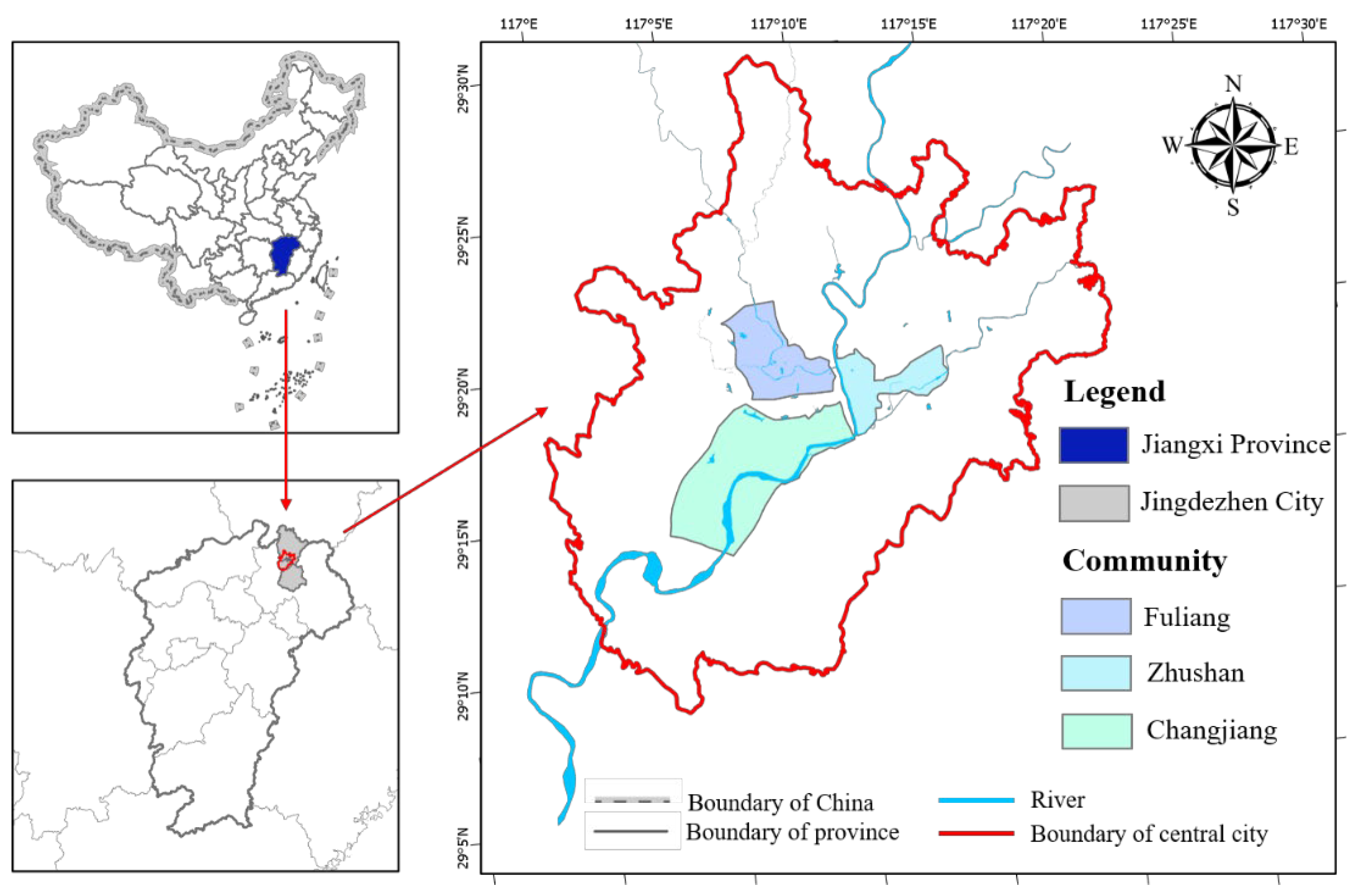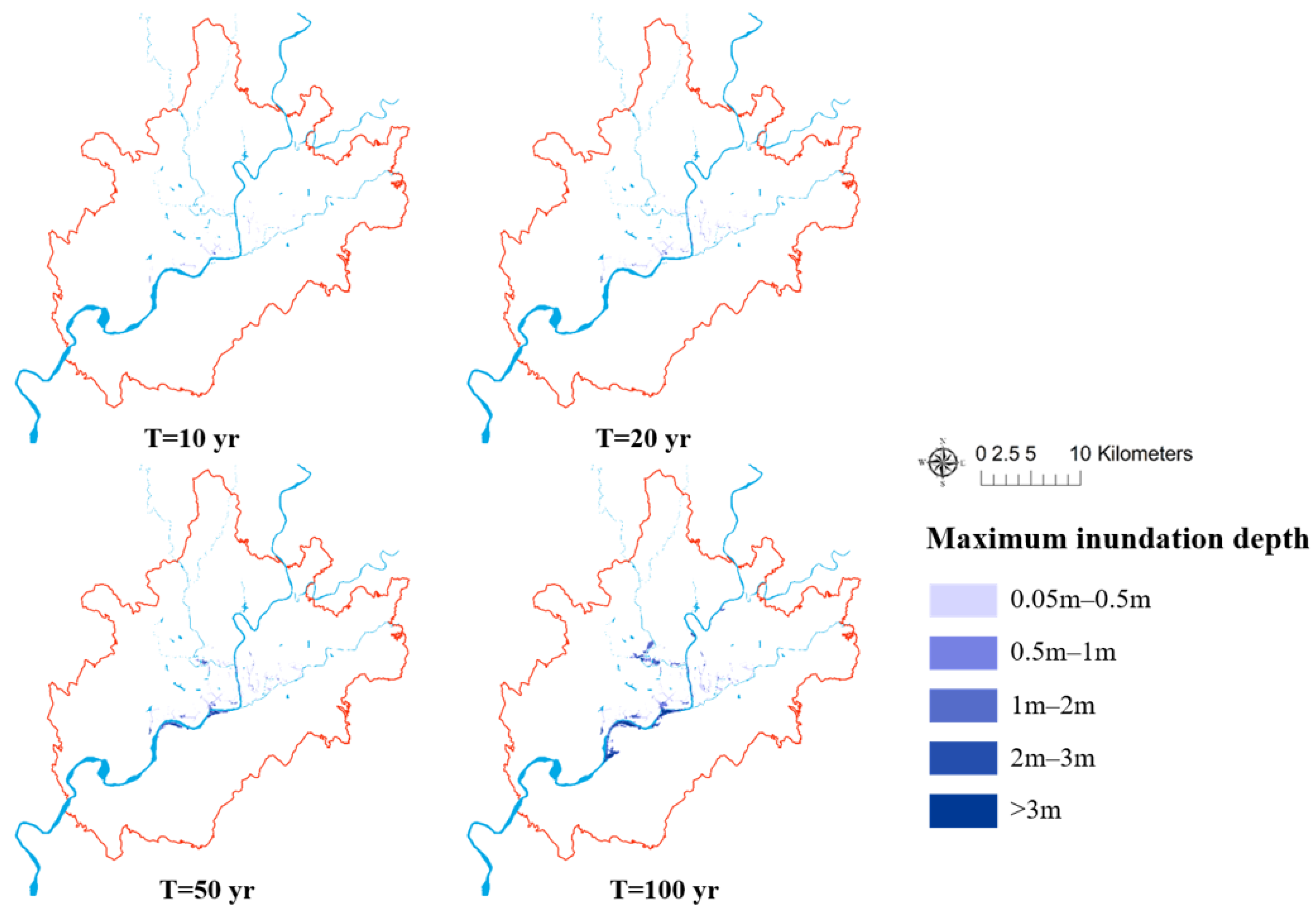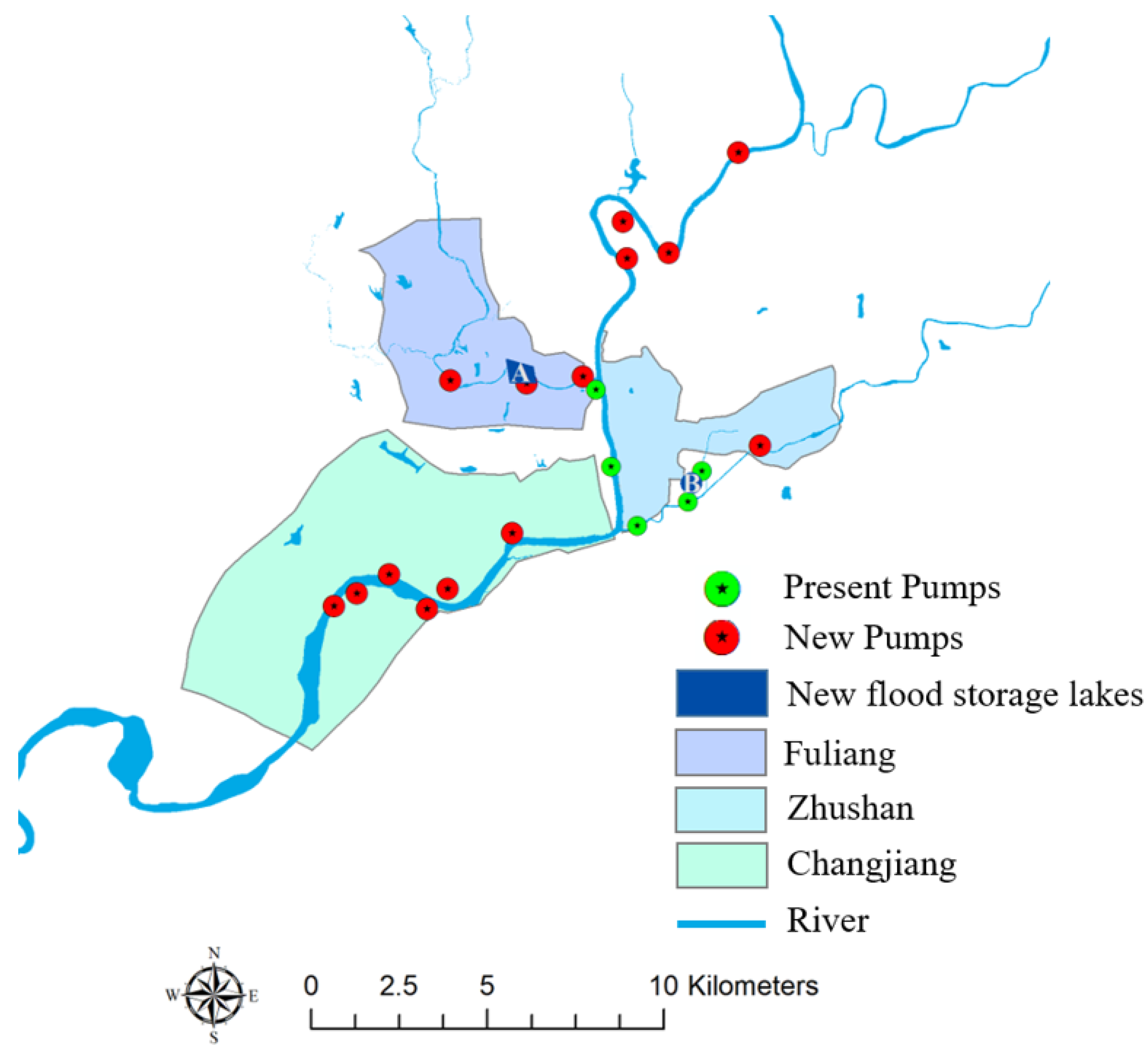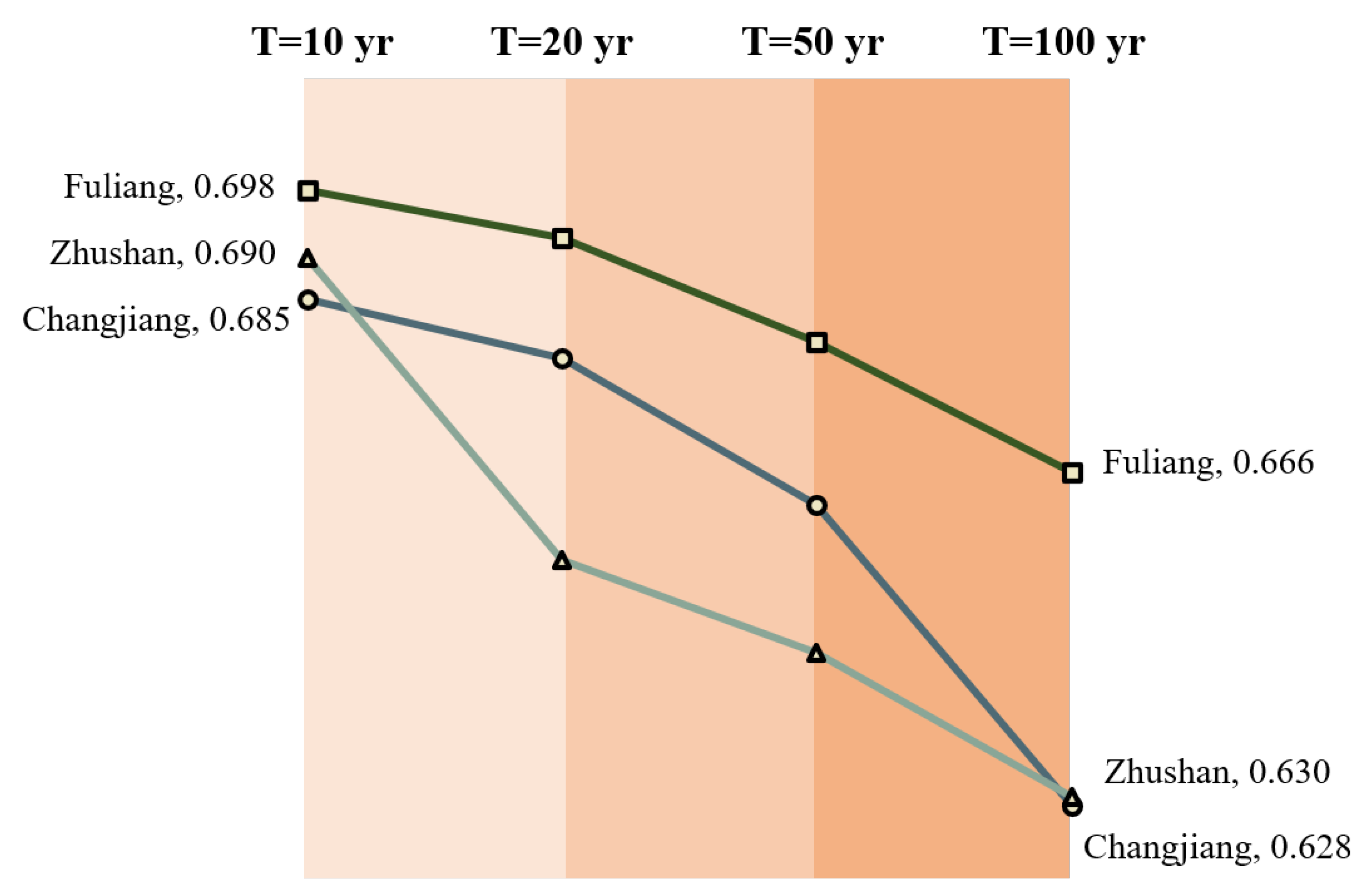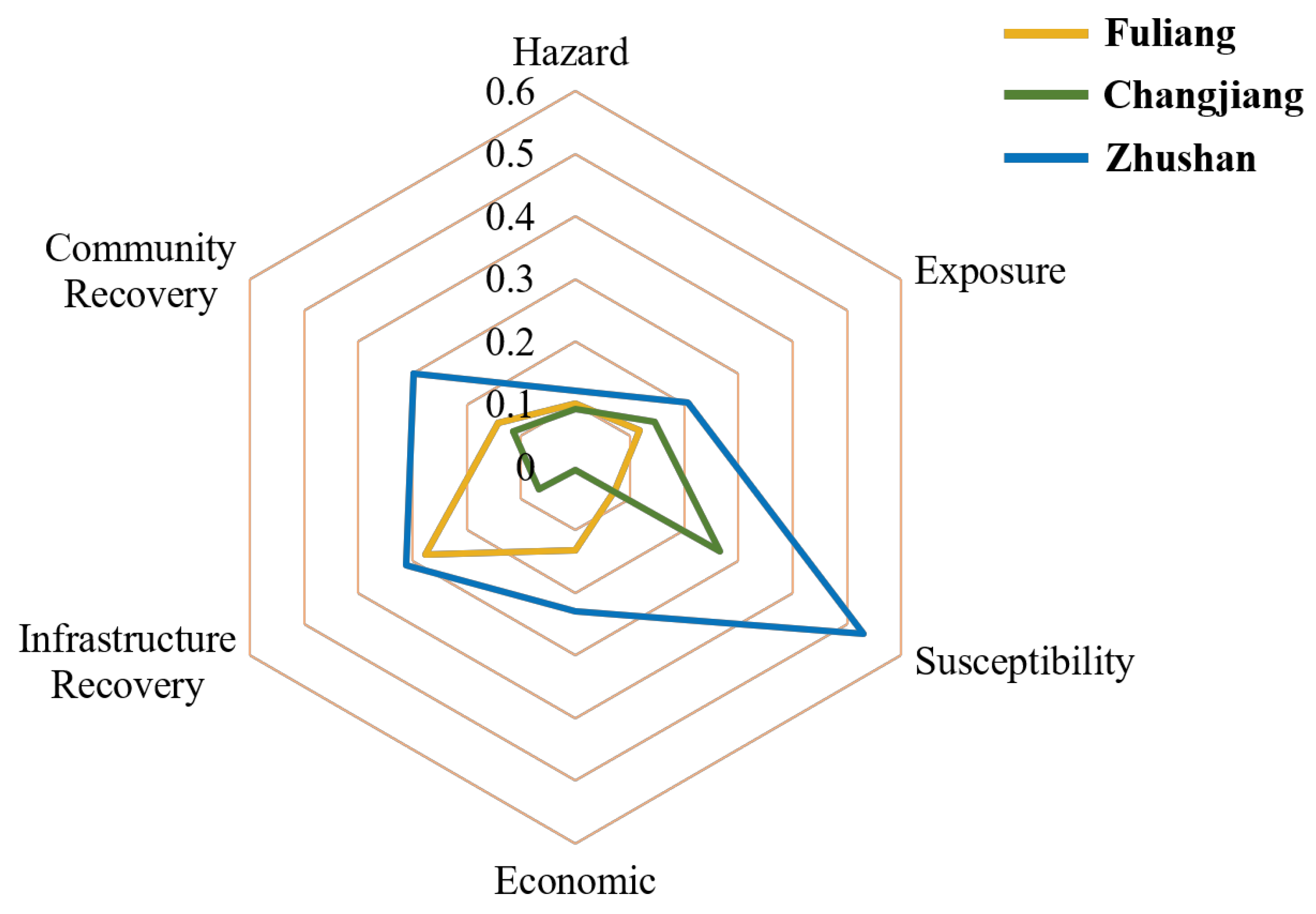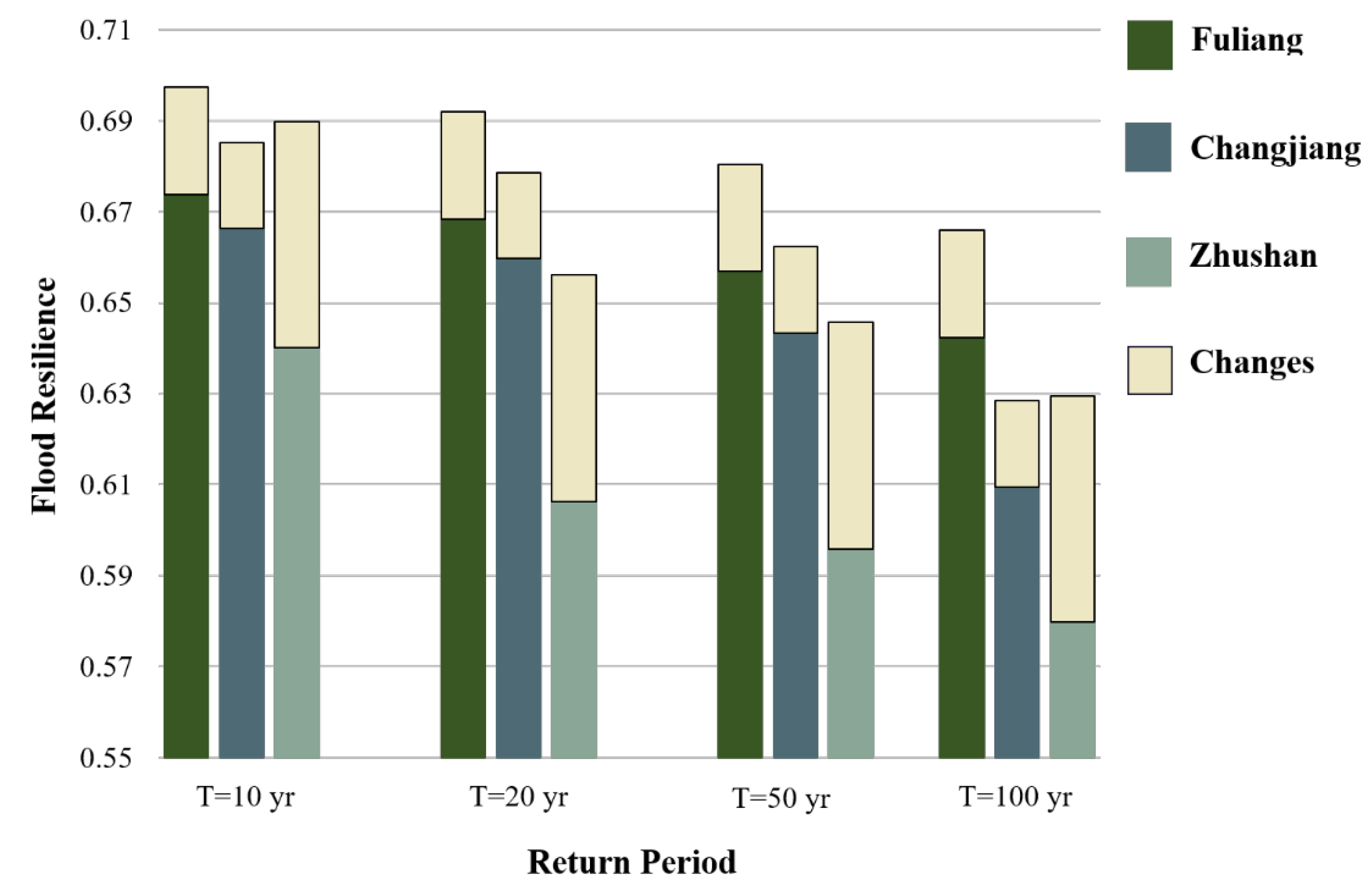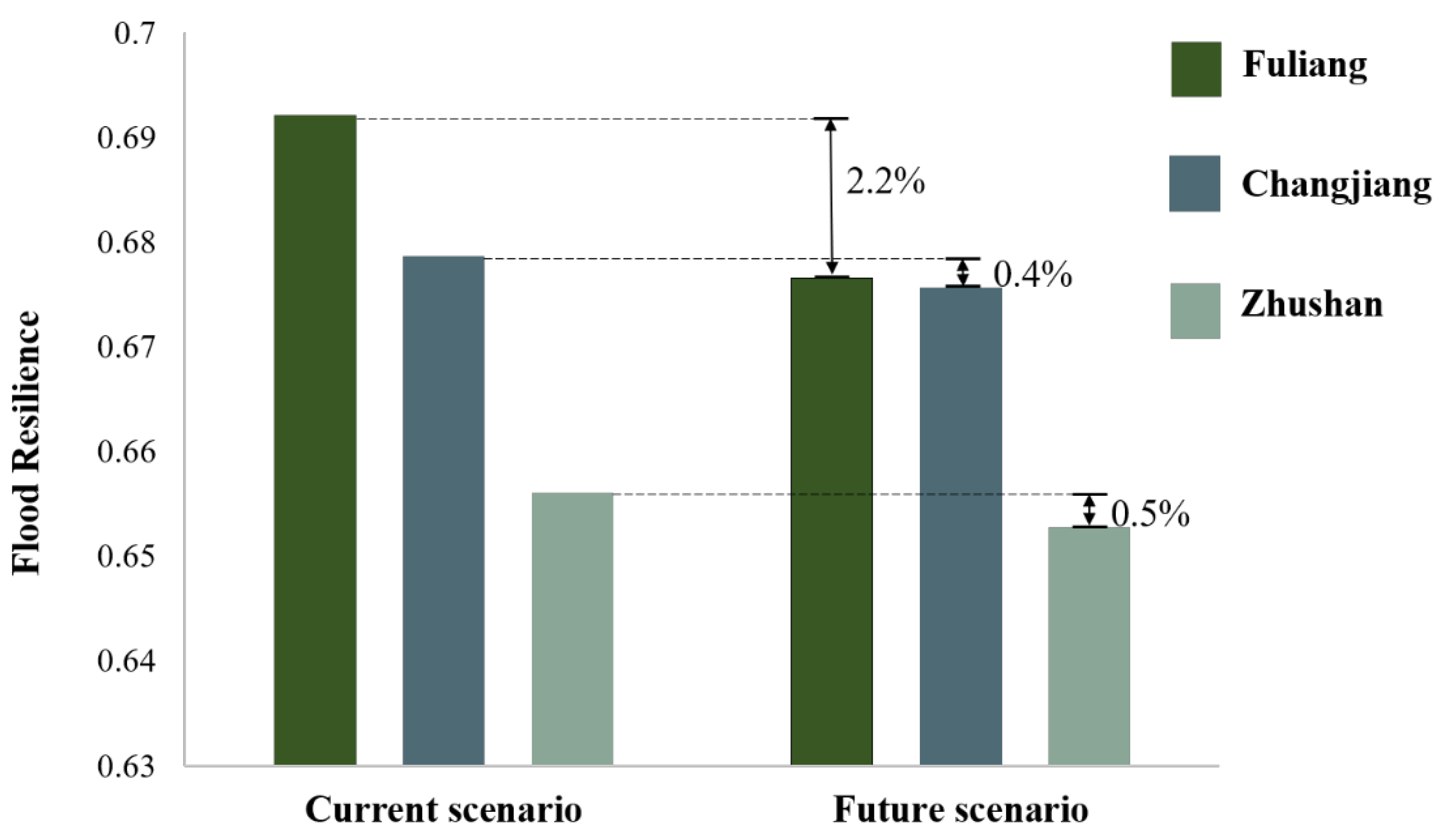1. Introduction
In the background of climate change and rapid urbanization, the changes of the human lifestyle and production has influenced rainfall, runoff, and other hydrological processes [
1], which has manifested the frequent occurrence of extreme rainstorms and the escalation of urban floods in urbanized areas. It has been highlighted that climate change imposes a non-linear nature of impacts on streamflow and floodplain inundation, thus affecting water resources and the frequency of floods in different basins around the world [
2,
3,
4]. The total direct flood losses in high urbanized cities in China have reached 42 billion USD in the year 2020 according to the statistical data of Chinese Flood and Drought Disaster Bulletin [
5], which reveals the fact that cities are facing great challenges in urban flood control and prevention. As the current situation of population growth and urbanization continues, it is expected that more of the population will be exposed to risk as well as aggregated assets. Nowadays, more than half of the world population are living in urban areas, and this number is expected to reach 75% by the year 2050 [
6,
7]. Urban systems are facing an unprecedented crisis that urgently requires a new understanding of urban disaster risk mitigation and control [
8].
Resilience as an emerging urban research direction, is essentially a proactive exploration of adjustment methods in response to the uncertain perturbations that modern cities face [
9], which can be adequate for acting as an indicator to evaluate the abilities of cities [
10]. The concept of resilience was proposed by the ecologist Holling in 1973 [
11]. It refers to the ability of a system to absorb external shocks and to quickly recover to the original state to keep the system stable. In recent years, the concept of resilience has shifted from an ecological to a multidimensional perspective [
12,
13,
14,
15,
16,
17,
18,
19]. Particularly, it has been frequently used in the field of climate change and disaster risk analysis. In early times, Brad Allenby defined resiliency as ‘the capability of a system to maintain its functions and structure in the face of internal and external change and to degrade gracefully’ from the perspective of disaster risk analysis in
Science in 2005 [
20]. Afterwards, in the popular discussion of climate change in urban areas, resilience is defined as ‘the capacity to withstand a wide array of shocks and stresses [
21]’ or ‘to dynamically and effectively respond to shifting climate circumstances while continuing to function at an acceptable level [
22]’. Furthermore, the urgent need of cities to help them better prepare for and recover from disasters emerged that resilience in disaster management began to gain attention from researchers [
23].
Building resilience in cities is considered as an effective measure for dealing with urban disaster issues [
24]. In 2009, a framework for building a disaster-risk-reduced resilient city in response to climate change was proposed by the Institute of Global Environment in Kyoto University, Japan [
25]; The Bonn ‘Resilient City’ conference series were held in 2010 to discuss climate resilience chapters; and the UNISDR has been organizing and implementing the Make Cities Resilient Campaign since 2012. The United Nations International Disaster Reduction Agency (UNISDR) proposed a research framework on disaster risk reduction to build urban disaster resilience in 2014. With these proposals and guidelines of building resilience, practices have been put forward to enhance urban resilience. For example, the Netherlands’ Rotterdam Climate Adaptation Strategy [
26] enhances urban resilience by building green infrastructure, water plazas, and other more resilient infrastructures. The New York Adaptation Plan [
27] was developed after the hurricane sweep, with two types of measures, infrastructure and urban reconstruction, as entry points to enhance the city’s ability to cope with future climate disaster risks in order to build a resilient city. Japanese scholars proposed a territorial design plan based on improving the quality-of-life level of residents as a post-disaster urban resilience enhancement strategy, which includes measures such as territorial reconstruction, a road opening plan, and village diversions [
28]. Indian scholars identified that spatial planning strategies contribute to community resilience to a great extent [
29]. Some scholars also pointed out that urban resilience should be improved by enhancing the resilience of important infrastructures and key nodes within cities [
30,
31,
32].
Focusing on urban flood resilience, it is defined as the capacity of the city to tolerate flooding and to recognize when physical damage and socioeconomic disruption occur, so as to prevent deaths and injuries and maintain their current socioeconomic identity [
33]. Studies on flood resilience assessment are mainly focused on examining the performance of cities and communities under disaster scenarios [
34,
35]. Louise Bertilssona [
36] created the multi-criteria urban flood resilience assessment framework S-FRESI, that incorporates water depth simulations into the index and calculated the flood resilience of several smaller areas within a community under different scenarios. Chen [
37] built a conceptual time-varying urban flood resilience index where the generated resilience results were mainly based on the time-dependent rainfall-inundation simulations. It can be seen that the introduction of the flooding process is useful for studying the performance of the system. In fact, urban flooding can be intervened by different engineering and non-engineering measures before, during, and after rainstorm events. It is meaningful to explore the effects of these measures and to find out how they can influence cities.
The available flood resilience enhancement strategies are proposed based on resilient city frameworks and local flood protection policies by the government. For example, the University of Groningen studied the data from policy makers and local communities to reconstruct the strategy, process, and anticipated outcome of Bangkok’s flood resilience policy [
38]. Diponegoro University investigated the documentation of resilience planning policies of Indonesia from national to local-level efforts [
39]. The UK and European countries have led the way in proposing more specific strategies for resilience enhancement. The UK Climate Preparedness Plan (UKCIP) [
40] proposed two main types of actions to deal with floods: (1) improve the emergency resilience of residents (including raising public awareness of natural disasters and enhancing resilience); and (2) insist on sustainable infrastructure development. The EU 7th Framework Project STAR-FLOOD [
41,
42,
43] investigated strategies for coping with flood risks in 18 vulnerable urban areas in six European countries (Belgium, UK, France, Netherlands, Poland, and Sweden). The project states that resilience enhancement strategies need to be carried out in the following directions: (1) establish adaptive management to help implement defence and mitigation measures that can be adjusted to suit changing circumstances; (2) deliver spatial planning so that consequences are prevented and minimized if floods occur; (3) improve forecasting, warning, and emergency response systems; (4) develop strategies for flood recovery for all residents to motivate them to adopt prevention and mitigation measures; and (5) establish institutional systems that promote learning and innovation.
In summary, the key to improve urban disaster resilience lies in solving the mismatching between the intensification of natural disasters and social acceptance. According to the above literature review, researchers generally propose countermeasures from two major aspects: planning and management, to formulate strategies for disaster resilience enhancement. On one hand, from the perspective of urban planning, plans are made for population and building development, lifeline system construction, disaster prevention, infrastructure construction, community reconstruction, etc. Specific implementation paths are developed by combining the characteristics of cities and communities. On the other hand, from the management perspective, there is a shift to adaptive management, including raising the knowledge and preparedness of natural hazards, improving emergency response capacities, and developing a public awareness of resilience. In other words, building resilient cities cannot only rely on hard engineering measures, but depends on adaptive strategies for disaster response as well [
28]. Taking the Great East Japan Earthquake as an example, local residents were too relieved by the huge 10 m high tidal dike built by the government and lacked awareness and preparedness, so it caused a delay in evacuation actions, resulting in deaths. In recent years, some of the latest resilience enhancement guidelines have incorporated adaptive strategies such as public awareness of pre-disaster preparedness and post-disaster emergency responses. For example, The EU STAR-FLOOD Project proposed a flood recovery strategy for all residents to encourage the adoption of prevention and mitigation measures to cope with flooding.
It can be seen that engineering planning and adaptive management are both very important resilience enhancement strategies. But it is not that clear regarding what types of strategies are more effective for resilience enhancement and how different types of measures influence the urban system when floods happen. A comparison between engineering strategies and adaptive strategies is presented in this paper to evaluate their effectiveness and provides evidence for resilience building in the next step. This study examines the applicability and impact of different types of resilience enhancement measures in three typical flood-prone communities. The specific objectives of this study are to (1) compare urban flood resilience in three flood-prone communities between present and future scenarios; (2) investigate the effects of two types of resilience enhancement measures (engineering measures and adaptive measures) of different flood-prone communities in the future scenario; and (3) project specific measures for each individual community according to their features and provide new ideas for flood-prone communities in a resilient way.
The rest of the paper is organized as follows.
Section 2 introduces the study area of central Jingdezhen city in China and its datasets. In
Section 3, two types of flood resilience enhancement measures are introduced and the improved approach to assess flood resilience is explained in detail. In
Section 4 and
Section 5, the results of flood resilience assessments in three typical flood-prone communities are provided and the impacts of flood resilience enhancement measures in current and future scenarios are discussed. Finally, in
Section 6, the conclusion highlights the applicability of flood resilience enhancement strategies and the limitation of the research, as well as the consideration for managerial insight and future work.
5. Discussion
This paper provides the first quantitative comparison of resilience enhancement effects of engineering measures and adaptive measures. The findings show that in the future, the overall positive effect of adaptive measures on the three communities is three times higher than that of engineering measures. Compared with similar studies, resilience improvement strategies are evaluated in different resilience research frameworks [
50,
51], but there is a lack of quantitative and comparative analyses of specific measures. It is therefore unclear to what extent the measures will affect regional resilience and to what extent they will make a difference. This study explains that engineering measures have a significant effect on increasing resilience in some flood-prone communities, for the fact that the implementation of engineering measures has changed drainage and inundation. But there is a practical consideration that building flood protection infrastructures is exorbitantly expensive and implicates long-term costs [
52] and that the government cannot invest regardless of the cost; in the meanwhile, there is not much more space to impose engineering measures due to a relatively saturated state of urbanization. Adaptive measures would be a better option at this point. With such a comparative analysis, the community policy makers could know how to develop valid strategies. The results of the quantitative analysis are not intended to discuss the details of implementing these measures, but it is important to give an example of the comparison between two types of measures in the perspective of flood resilience. From which the community policy makers should know how to develop valid strategies.
The results of the quantitative analysis indicate that the level of flood resilience is influenced by the awareness and preparedness of individual residents. Compared with the adaptive measures put forward in other resilience frameworks, the indicators of awareness and preparedness have been specially emphasized in this study, which has also been mentioned and found useful by other scholars [
28]. We believe that individual residents’ risk awareness and preparedness play an important role in the implementation of community flood control work in a long-term perspective. In the future, attempts should be made to incorporate this criterion in community development plans, so as to form more complete disaster response strategies and resilience plans. The local government of Jingdezhen City is also interested in this work, which shows that the government as well as the community are aware of these issues and want to improve the flood control level of the city by enhancing flood resilience.
Three flood-prone communities in Jingdezhen are selected to show the resilience performance under different scenarios. The selected flood-prone communities are all exposed to long-term flood risk. But three communities have different natural and social-environmental characteristics: the layout of engineering measures, proximity to the river, and community management, which ultimately present variability in flood resilience. Therefore, the role of the community is very important in building a resilience framework closely related to the localized characteristics when implementing measures. Communities with a low level of engineering construction still have space and capacity to build flood control projects and should be given priority to making these engineering plans. Communities seated by the river should not be too relieved for the well-constructed dams and dykes to lose awareness and preparedness, especially those densely populated and with aging communities. Communities should provide adequate flood risk education to residents, encourage vulnerable people to participate in flood risk management, and set up temporary emergency shelters to improve flood response capacity in emergency situations.
The limitation of this study is the limited sample size and uneven sample distribution of the questionnaire survey in the three communities. Improvements are required in designing the survey process that could make the community indicator of awareness and preparedness more objective in the following surveys. The other limitation is about the evaluation of the economic recovery indicator, where the socio-economic property losses due to floods are generated based on depth–damage curves. It is an estimated quantity that can reflect the losses to some extent, but the evaluation could be better if statistical data are available.
